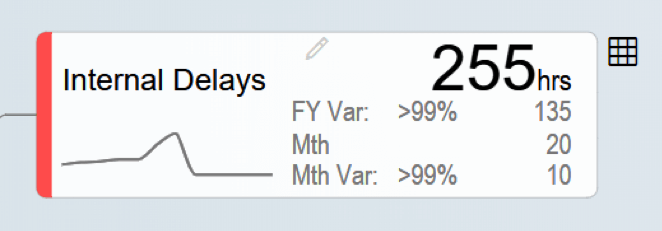Value driver trees are an ideal tool for modeling business scenarios and enable you to visualize the operating procedure and the most important key figures. Unlike traditional reports or dashboards, this visualization gives you much deeper insight and analysis. Why? Because it maps the relationship between different operational processes to your company's key indicators through a logical and/or mathematical linkage, which can include simulations and what-if scenarios.
One important feature for a good value driver tree is the flexibility to map all value-driving data in the tree structure. While traditional Value Driver Trees represent only the operational drivers and business KPIs, a really good model must include more analysis functions, such as the ability to penetrate one of the drivers and look at the key factors that contribute to the value of that driver.
The Value Driver Tree of Visual BI offers you exactly that possibility. You can use drilldwon to assign data to a specific node in the value driver tree using a "dimensional node". The Value Driver Tree also offers a useful node function for complex business forms: If your company has different business units, you can map around 80 percent of these value driver trees thanks to templated nodes and only have to enter the individual differences between the single units.
This article deals with the two central node functions of the Value Driver Tree Tool and how you can use them to create your value driver tree:
1. Dimensional Nodes
2. Templated Nodes
1. Create dimensional Nodes for deeper Insights
Imagine you have a value driver tree that breaks net profits down into revenues and cost types. The Value Driver Tree gives you a clear overview of the different factors that influence both revenues and cost types. However, if you want to gain a more detailed insight into what lies behind a more general factor such as "delay" for example, you can display the data behind it in a new window. To do this, the dimensional node must be supplied in advance with external data, for example from the SAP Business Warehouse. You then gain a much deeper insight into the underlying data and can analyze the various value-driving factors much more precisely. It makes sense to use drilldown in dimensional nodes, especially in value driver trees, which otherwise become too branched and confusing due to their abundance of elements.

In our example, we first created a "Dimensional Node" component within the Value Driver Tree Tool and used a BW data source to get the detail data of the internal delay into the component. We then included this dimension node component within the value driver tree model. If you want to view the detailed data, you only have to click on the "Table" icon next to the node. You see a pop-up window with the drilldown, which looks something like this:

If necessary, a comparison series for each of the existing dimension elements can also be displayed on a separate tab without any major effort - it simply has to be integrated as part of the data source.
2. Integrate templated Nodes
Another important feature of the Value Driver Tree Tool is the use of node templates. With this function you can save a lot of work and time when creating value driver trees with similar basic requirements.
Assuming your company is divided into three different business units, you want to create a net profit value driver tree for all three. In the area of costs, you are likely to have identical nodes for all three. These can be, for example, the purchase price for raw materials, the production costs, or the costs for services. These are displayed as individual nodes in the Value Driver Tree and can still contain subnodes. If individual nodes and the data behind them are identical for your individual business units, it makes sense to simply adopt them for all units.
You can do this easily in the Value Driver Tree of Visual BI. Best of all, the underlying nodes can also be copied to other value driver trees as templates. This way you can easily transfer a large part of the value driver tree to be created from existing nodes and only have to individualize the last 10 to 20 percent.
The Value Driver Tree Tool offers a broad range of functions that facilitate the analysis and simulation of your company's value drivers.
Would you like to learn more about the various functions and advantages of the Value Driver Tree Tool? Then get in touch with us for a personal demonstration:

























